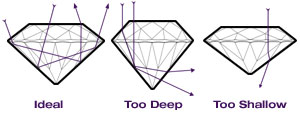|
|
|
|
|
Cut describes the proportions and angles of a diamond. Many people confuse cut with the shape of a diamond. Although nature determines the other three characteristics, it takes a master diamond cutter to reveal a diamond's true beauty. Diamonds are available in various shapes including round, square, pear, heart, marquise and oval but cut refers to the angles and proportions of a diamond.

A well cut diamond reflects light from one mirror-like facet to another and projects the light through the top of the stone. The result is a fiery and brilliant display. Diamonds that are cut too deep or too shallow leak light through the side or bottom, resulting in a lackluster appearance and diminish value.
|
|
|
Brilliance is the liveliness and sparkle exhibited by a diamond. It occurs when the maximum amount of light entering through the top of a diamond bounces inside from one facet to another and is then reflected back to the viewer’s eye.
Dispersion is a term that describes the flash of different colored light coming from the interior of a diamond. It occurs when white light is separated into its component rainbow colors as the light is passed through the facets of a diamond. Fire is another term used to describe dispersion.
Scintillation describes the quick flashes of light, resembling colorful, fiery sparks, reflected from a polished diamond. It occurs when either the diamond, the light source, or the observer moves. Sparkle is another term for scintillation.
|
|
Diamonds can come in many different shapes and sizes. The most common are Round, Pear, Emerald, Marquise, Oval, Radiant, Princess, Trilliant, Cushion, Asscher, and Heart. Of course there is also the Baguette, that ever popular diamond found in many engagement and wedding ring settings. There are many diamond cutters that create specialty shapes like the Flanders, Kites, Stars and even Half Moons. Typically specialty cut diamonds are in demand because of their unusual shapes that help create unique jewelry. Other specialty cust diamonds might look like a standard Round, when in fact they have more more facets than the standard 58. Expert diamond cutters through the years have studied refractions of light using complex mathematics to create specialty cuts with spectacular fire and brilliance. Remember that while you shop for your perfect diamond, regardless if it has 58 facets, 70 facets or 105 facets, you need to find that diamond that looks perfect to your own eye, regardless what any certification might say.
|
|
